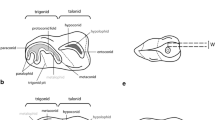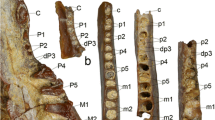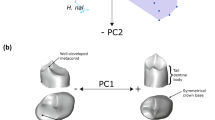Abstract
It is generally accepted that the South American marsupial family Caenolestidae is characterized in part by the absence or noneruption of the third deciduous premolar (dP3) in both jaws, although juvenile stages have rarely been identified in extant or fossil representatives of the family. Published illustrations of the dentary of the Miocene caenolestid Stilotherium suggested to us, however, that P3 erupted relatively late during ontogeny, after the eruption of M4. In extant marsupials, this eruption sequence appears to represent the plesiomorphic state and this pattern is generally associated with the eruption of dP3 earlier in ontogeny, and its subsequent replacement by the erupting P3. Therefore, we suspected that a dP3 erupted in earlier ontogenetic stages of caenolestids; to test this hypothesis we searched the mammalogy collections of three museums for evidence of dP3 in juvenile specimens of caenolestids. Examination of more than 180 specimens of the three extant genera of caenolestid marsupials resulted in the identification of only nine juvenile or subadult stages of dental eruption. Seven specimens of Caenolestes and Rhyncholestes corroborated our hypotheses of late eruption of P3 in Caenolestidae. In addition, the two youngest specimens of Caenolestes possessed a tiny, rudimentary dP3, measuring about 0.4 to 0.5 mm in greatest length, associated with a mesiolingual eruption pit containing the apex of the larger P3 in very early phases of eruption above the alveolar margins. The tiny dP3 is clearly nonfunctional in occlusion, and it is questionable whether it erupted above the gun margins in life. Comparison of the dentaries of subadult caenolestids with four dentaries of the Miocene genus Stilotherium corroborated our initial impression that the fossil genus exhibited evidence of a late-erupting P3, comparable to the condition in extant caenolestids. We suggest that examination of other specimens of juvenile dentitions, skulls, and skeletons in museum collections can provide additional insight into the developmental and evolutionary biology of mammals.
Similar content being viewed by others
LITERATURE CITED
Ameghino, F. (1887). Enumeración sistemática de las especies de mamíferos fósiles coleccionados por Carlos Ameghino en los terrenos eocenos de la Patagonia austral y depositados en el Museo de La Plata. Bolet. Museum La Plata 1: 1–26.
Ameghino, F. (1894). ´Enumération synoptique des espèces de mammifères fossiles des formations Èocènes de Patagonie. Bolet. Acad. Nac. Cienc. Córdoba 13: 259–452.
Ameghino, F. (1897). Mammifères crétacés de l'Argentine. Bolet. Inst. Geograf. Argent. 18: 405–521.
Ameghino, F. (1903). Los diprotodontes del orden de los plagiaulacoideos y el origen de los roedores y de los polimastodontes. An. Museum Nac. Buenos Aires 9: 81–192.
Ameghino, F. (1906). Les formations sédimentaires du Crétacé supérieur et du Tertiaire de Patagonie avec un parallèle entre leurs faunes mammalogiques et celles de l'ancien continent. An. Museum Nac. Buenos Aires 15: 1–568.
Aplin, K. P., and Archer, M. (1987). Recent advances in marsupial systematics with a new syncretic classification. In: Possums and Opossums: Studies in Evolution, M. Archer, ed., pp. xv–lxxii, Surrey Beatty and Sons, Chipping Norton, NSW.
Archer, M. (1978). The nature of the molar-premolar boundary in marsupials and a reinterpretation of the homology of marsupial cheekteeth. Mem. Queensl. Museum 18: 157–164.
Bensley, B. A. (1903). On the evolution of the Australian Marsupialia; with remarks on the relationships of the marsupials in general. Trans. Linn. Soc. Lond. 9: 83–217.
Berkovitz, B. K. B. (1968). The early development of the incisor teeth of Setonix branchyurus (Macropodidae: Marsupialia) with special reference to the prelacteal teeth. Archs. Oral Biol. 13: 171–190.
Bublitz, J. (1987). Untersuchungen zur Systematik der rezenten Caenolestidae. Bonn. Zool. Monogr. 23: 1–96.
Cifelli, R. L., and de Muizon, C. (1998). Tooth eruption and replacement pattern in early marsupials. C. R. Acad. Sci., Sci. Terre Planètes 326: 215–220.
Cifelli, R. L., Rowe, T. R., Luckett, W. P., Banta, J., Reyes, R., and Howes, R. I. (1996). Fossil evidence for the origin of the marsupial pattern of tooth replacement. Nature (London) 379: 715–718.
Godthelp, H., Wroe, S., and Archer, M. (1999). A new marsupial from the early Eocene Tingamarra Local Fauna of Murgon, Southeastern Queensland: A prototypical Australian marsupial? J. Mammal. Evol. 6: 289–313.
Hershkovitz, P. (1992). The South American gracile mouse opossums, genus Gracilinanus Gardner and Creighton, 1989 (Marmosidae, Marsupialia): A taxonomic review with notes on general morphology and relationships. Fieldiana Zool. [N. S.] 70: 1–56.
Kelt, D. A., and Martínez, D. R. (1989). Notes on distribution and ecology of two marsupials endemic to the Valdivian forests of southern South America. J. Mammal. 70: 220–224.
Kirkpatrick, T. H. (1969). The Dentition of the Marsupial Family Macropodidae with Particular Reference to Tooth Development in the Grey Kangaroo Macropus giganteus Shaw. Unpublished Ph.D. Thesis, University of Queensland, Brisbane.
Lönnberg, E. (1921). A second contribution to the mammalogy of Ecuador with some remarks on Caenolestes. Arkiv Zool. 14: 1–104.
Luckett, W. P. (1993). An ontogenetic assessment of dental homologies in therian mammals. In: Mammal Phylogeny: Mesozoic Differentation, Multituberculates, Monotremes, Early Therians, and Marsupials, F. S. Szalay, M. J. Novacek, and M. C. McKenna, eds., pp. 182–204, Springer-Verlag, New York.
Luckett, W. P. (1994). Suprafamilial relationships within Marsupialia: Resolution and discordance from multidisciplinary data. J. Mammal. Evol. 2: 255–283.
Luckett, W. P., and Hong, N. (1998). Phylogenetic relationships between the orders Artiodactyla and Cetacea: A combined assessment of morphological and molecular evidence. J. Mammal. Evol. 5: 127–182.
Luckett, W. P., and Woolley, P. A. (1996). Ontogeny and homology of the dentition in dasyurid marsupials: Development in Sminthopsis virginiae. J. Mammal. Evol. 3: 327–364.
Marshall, L. G. (1980). Systematics of the South American marsupial family Caenolestidae. Fieldiana Geol. [N. S.] 5: 1–145.
Marshall, L. G. (1982). Systematics of the South American marsupial family Microbiotheriidae. Fieldiana Geol. [N. S.] 10: 1–75.
Marshall, L. G., Case, J. A., and Woodburne, M. O. (1990). Phylogenetic relationships of the families of marsupials. In: Current Mammalogy, Vol. 2, H. H. Genoways, ed., pp. 433–505, Plenum Press, New York.
Merchant, J. C., Newgrain, K., and Green, B. (1984). Growth of the eastern quoll, Dasyurus viverrinus (Shaw), (Marsupialia) in captivity. Aust. Wildl. Res. 11: 21–29.
Osgood, W. H. (1921). A monographic study of the American marsupial, Caenolestes. Field Museum Nat. Hist. Zool. Ser. 14: 1–162.
Pascual, R., and Herrera, H. E. (1975). Stilotherium Ameghino, 1887, el más primitivo Caenolestidae conocido. Consideraciones sobre la transición Didelphidae-Caenolestidae (Marsupialia). Actas Prim. Congr. Argent. Paelontol. Bioestrat. (Tucuman, Argentina, 1974) 2: 417–430.
Reig, O. A. (1955). Un nuevo género y especie de cenolestinos del Plioceno de la provincia de Buenos Aires (RepÚblica Argentina). Rev. Assoc. Geol. Argentina 10: 60–71.
Ride, W. D. L. (1962). On the evolution of Australian marsupials. In: The Evolution of Living Organisms, G. W. Leeper, ed., pp. 281–306, Melbourne University Press, Melbourne.
Sinclair, W. J. (1906). Mammalia of the Santa Cruz Beds. Marsupialia. Rep. Princeton Univ. Expeditions Patagonia. IV: 333–460.
Szalay, F. S. (1994). Evolutionary History of the Marsupials and an Analysis of Osteological Characters, Cambridge University Press, New York.
Thomas, O. (1895). On Caenolestes, a still existing survivor of the Epanorthidae of Ameghino, and the representative of a new family of recent marsupials. Proc. Zool. Soc. Lond. 1895: 870–878.
Tomes, R. F. (1863). Notice of a new American form of marsupial. Proc. Zool. Soc. Lond. 1863: 50–51.
Woodward, M. F. (1893). On the development of the teeth of the Macropodidae. Proc. Zool. Soc. Lond. 1893: 450–473.
Author information
Authors and Affiliations
Rights and permissions
About this article
Cite this article
Luckett, W.P., Hong, N. Ontogenetic Evidence for Dental Homologies and Premolar Replacement in Fossil and Extant Caenolestids (Marsupialia). Journal of Mammalian Evolution 7, 109–127 (2000). https://doi.org/10.1023/A:1009406632509
Issue Date:
DOI: https://doi.org/10.1023/A:1009406632509




